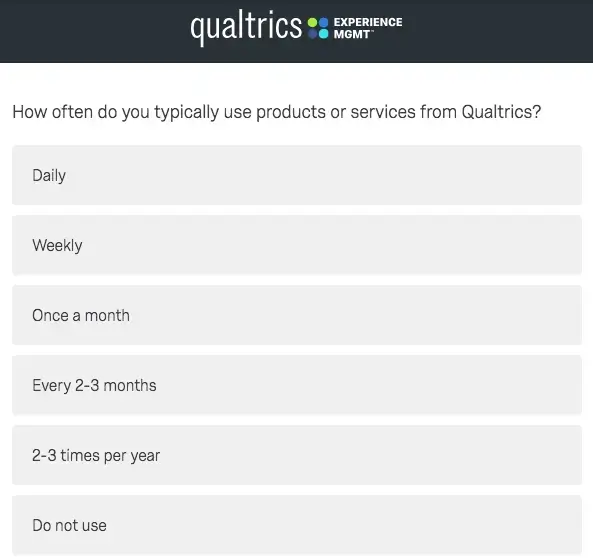
21 min read
Consumers expect an exceptional experience with your company, and unfortunately, people talk about bad customer experiences more than they’ll brag about good ones. Read on to learn why satisfaction data is valuable information, and how to optimize your customer satisfaction surveys for useful insights.
A customer satisfaction (CSAT) survey is used to determine a CSAT score by asking customers the question ‘How satisfied are you with [organization]? Answers range from 1-5 with 5 being “highly satisfied” and 1 being “highly unsatisfied”.
They are used to understand your customer’s satisfaction levels with your organization’s products, services, or experiences. This is one type of customer experience survey and can be used to gauge customers’ needs, understand problems with your products and/or services, or segment customers by their score. They often use rating scales to measure changes over time, and gain a deeper understanding of whether or not you’re meeting the customer’s expectations.
Customer satisfaction is at the core of human experience, reflecting customers’ liking of a company’s business activities. A customer satisfaction survey is a great way to understand how your customer feels about your business and their customer journey, and to nail down exactly what new customers might like about your offering.
There are several reasons why measuring your audience’s views with a customer satisfaction survey can be beneficial to your brand.
Our recent 2022 Global Consumer Trends Report found that 62% of customers think brands need to care about them more. With 9.5% of your revenue at risk from customers walking after a bad experience, knowing how your customers feel is financially beneficial. Gathering feedback via a customer satisfaction survey means you can figure out how to care for customers – and to monitor changes in customer sentiment before small issues become real problems.
Our research also found that 60% of consumers would buy more if businesses treated them better. Measuring which interactions and experiences your customers value will help you to judge what they will pay more for.
Americans will mention a positive experience to an average of nine people and a negative experience to an average of 16. This can have a knock-on effect for your brand reputation. According to Nielsen, 84% of consumers they surveyed thought word-of-mouth was the most trustworthy recommendation type. With every experience potentially attracting or pushing away future customers that hear of you this way, it’s vital to monitor how your customers feel with a customer satisfaction survey.
High levels of satisfaction (with pleasurable experiences) are strong predictors of customer and client retention and product repurchase. Customer satisfaction data that answers why loyal customers or clients enjoyed their experience helps the company recreate these experiences in the future. Effective businesses focus on creating and reinforcing world-class experiences so that they retain existing customers and add new customers.
Mapping your customer journey is an important step of understanding your customers’ interactions with your brand – and for building out your customer lifecycle. However, it’s not enough to just create your journey map. You need to know how your customers feel at each stage of their experience with your brand, from the first interaction to getting in touch with customer service representatives, to making a purchase. A customer satisfaction survey can put your finger on the pulse of customer sentiment and give you a great sense of where your journey needs updating maximum efficacy.
To understand how satisfied your customers are, you need to understand the key drivers behind their experiences. The best way of discovering not only how your customers feel, but what has caused them to feel the way they do is by creating customer satisfaction surveys.
However, customer satisfaction feedback can be nebulous. Giving your customers a framework for their feedback – such as likelihood to recommend with a scale of 0 – 10 – can help you contrast and compare answers over time, as well as develop insights and action across multiple relationships.
Choosing the type of customer satisfaction survey you wish to create will help you to develop a metric for measuring – and improving – your customer satisfaction.
There are a few ways you can measure customer experience through customer or client satisfaction surveys. The first question you need to answer is what metrics you want to use.
The most commonly used metrics are:
In this article, we will be focusing on customer satisfaction surveys (CSAT).
When building your customer satisfaction survey questions, the type of question you choose to ask can make a big difference to the insights you receive and your ability to improve the experience.
Here are the types and some sample customer satisfaction (CSAT) questions to help you decide which will get you the answers you’re looking for.
A Likert Scale question provides customers with options for their response from one extreme to another (i.e. satisfied to unsatisfied), with or without a neutral response.
For example, a five-point Likert scale question might look like this:
How satisfied are you with our service?
An even Likert scale question removes the middle response to provide a binary choice.
How satisfied are you with our service?
These types of customer satisfaction survey questions are simple to understand and answer, and will provide you with quantifiable customer satisfaction data.
However, the real attitude of your customers can’t usually be deduced by just this type of question alone. Customers might have specific drivers that aren’t highlighted by this question, or they might feel reluctant to choose an “extreme” option, even if it is true for their experience.
Binary questions provide you with the quickest response to any feedback survey question. By asking a simple yes/no question (or its equivalent), you can get the general sense of whether customers’ needs have been met.
For example, you could ask:
Were you satisfied with your experience with us?
[Smiley face/Unhappy face]
Did you find what you were looking for today?
Again, this does not provide you with the full context of their answer.
Multiple choice questions can enable you to find out more about customers and their experiences.
For example, you could ask:
[Service A]
[Service B]
[Service C]
This type of question can be more leading for your customers, as you are providing the text answers for them to choose from. However, it can offer you more insight than a simple binary or Likert scale question.
This type of question allows your customer to provide a description in their own words of how satisfied they are with your products or services.
For example, you could ask:
Open-ended questions can give you a much more specific insight into a particular customer’s problems or highlights. However, they are also higher effort for your customers – which may put them off responding.
Adding additional questions can help you sort through and take action on your customer feedback — just remember that shorter is generally better when it comes to survey completion rate.
Edit the usage frequency options below so that they are relevant to your industry or product. This helps you understand the user’s skill level with your product/service.

Product and usage survey questions can give you greater insight into how your customer base uses your products and services. Not only that, but you can learn more about how they feel about them as well. This can help inform not only how you approach customers, but also with your product development efforts. Incorporating customer feedback about your products, you know how to better meet their needs and improve their experience.
Product and usage survey questions you could ask include:
Demographic questions can be helpful in understanding what audiences or customer segments you are excelling with or under serving. We recommend getting as much of this data from your customer database or CRM, instead of asking for it in a survey whenever possible. Below are some potential demographic questions you can add to your customer satisfaction survey.
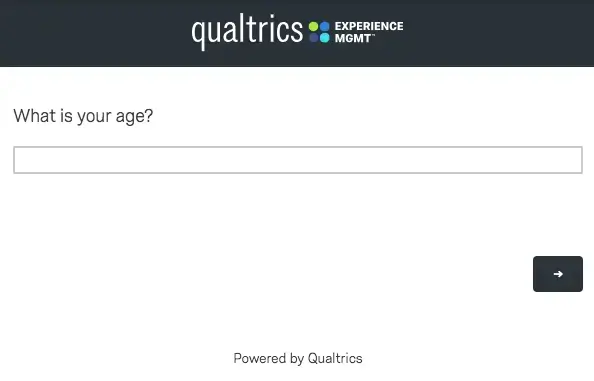
Unlike demographic survey questions, psychographic survey questions are more focused on psychological criteria. These questions can cover activities, interests and opinions, giving you a fuller picture of your customer profile. These questions can be open-ended, binary or multiple choice.
Psychographic questions might cover:
This type of question helps you identify satisfaction key drivers and highlight the areas of a customer’s experience that are important, allowing you to align product and service priorities. Below are potential categories of drivers.
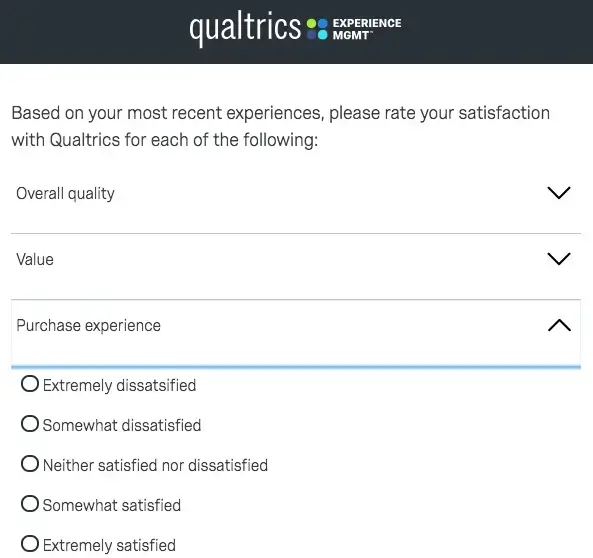
This question allows customers to provide unsolicited open-text feedback and their response to your customer satisfaction survey and mention specific topics or experiences for your team to review.
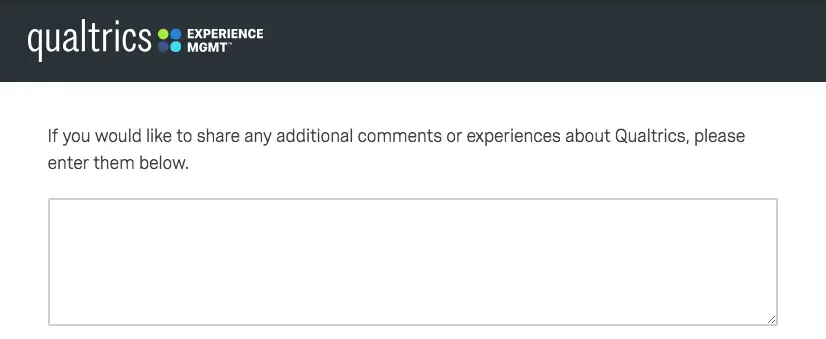
This is a simple question asking if it’s okay if a member of the team reaches out to the respondent to try and understand and resolve any pain points.
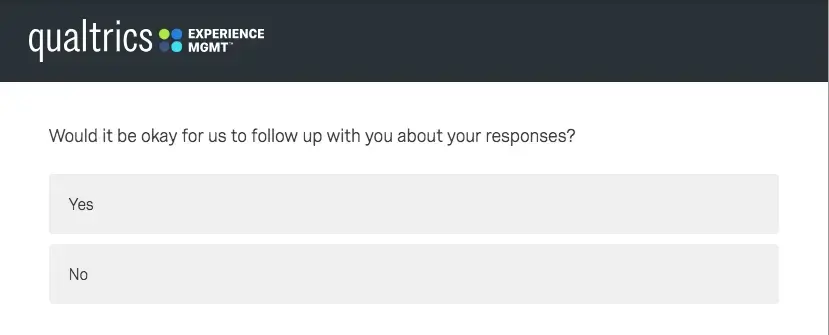
Properly constructed customer satisfaction surveys and questionnaires provide the insights that are the foundation for benchmarking customer happiness. Depending on what customer metrics you intend to use, it will determine what type of survey questions you need to ask your customers. Below are a few best practices:
Asking your customers about their experiences at any time might seem useful, but ideally you will link your customer satisfaction survey to specific points in the customer journey. Proper timing of customer satisfaction surveys depends on the type of product or service provided, the type and number of customers served, the longevity and frequency of customer/supplier interactions, and the intended use of the results.
Nevertheless, timing when to send a customer satisfaction survey is extremely important no matter the circumstances.
Best practices include:
Let’s look at an example of a customer journey from the airline industry. A customer satisfaction survey can be sent at every touchpoint in the process.
Measuring customer satisfaction is important but what you do with the data is essential. If your customers take the time to fill out a survey, it’s important they know you’re serious about improving their experience.
Do you want to go deeper into customer insights and create loyal and satisfied customers?
Though looking at customer satisfaction survey examples is helpful, we’ve gone one step further to create a customer satisfaction survey template to get you started.
Our prebuilt customer satisfaction survey template can be used in your customer experience management (CXM) to start properly measuring customer satisfaction. Keep in mind, all of these customer satisfaction surveys can be used today when you sign up for a FREE Qualtrics account.
Other Customer Feedback Resources: